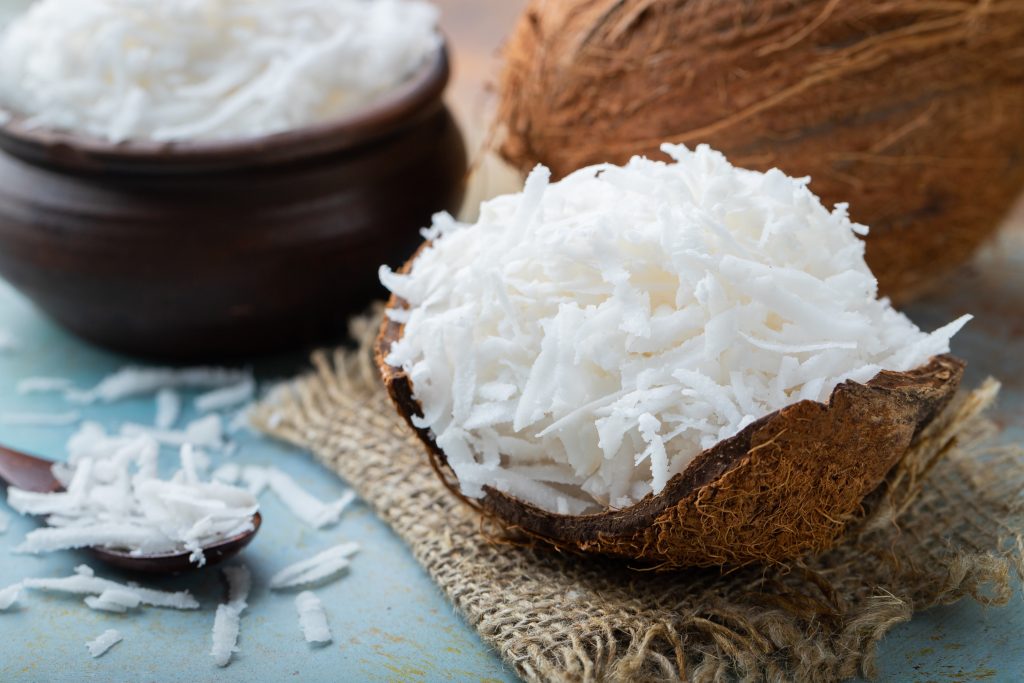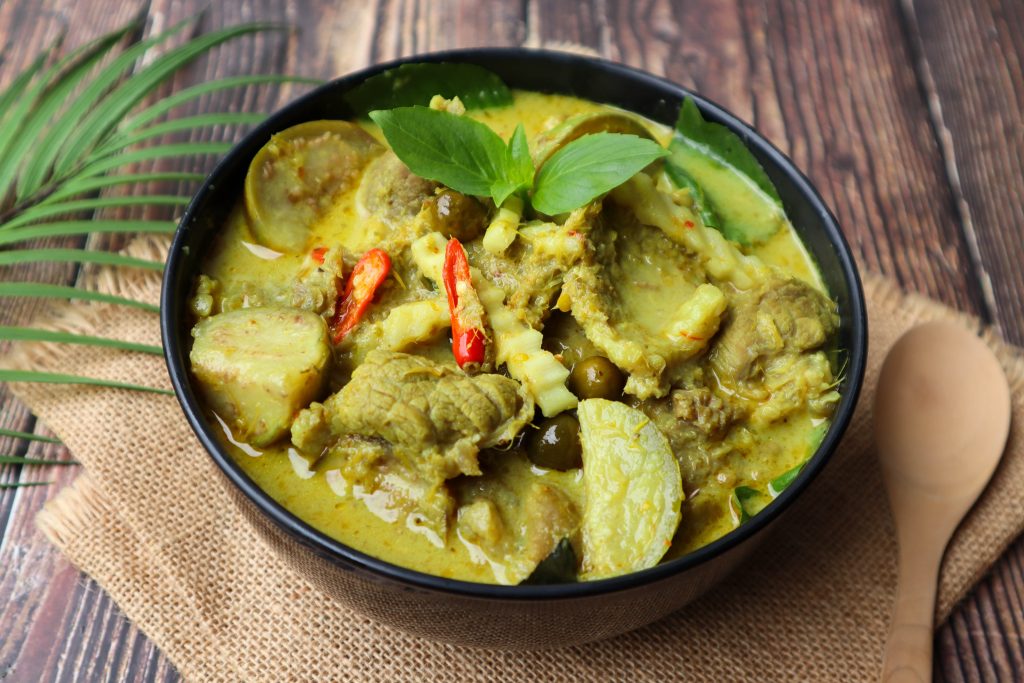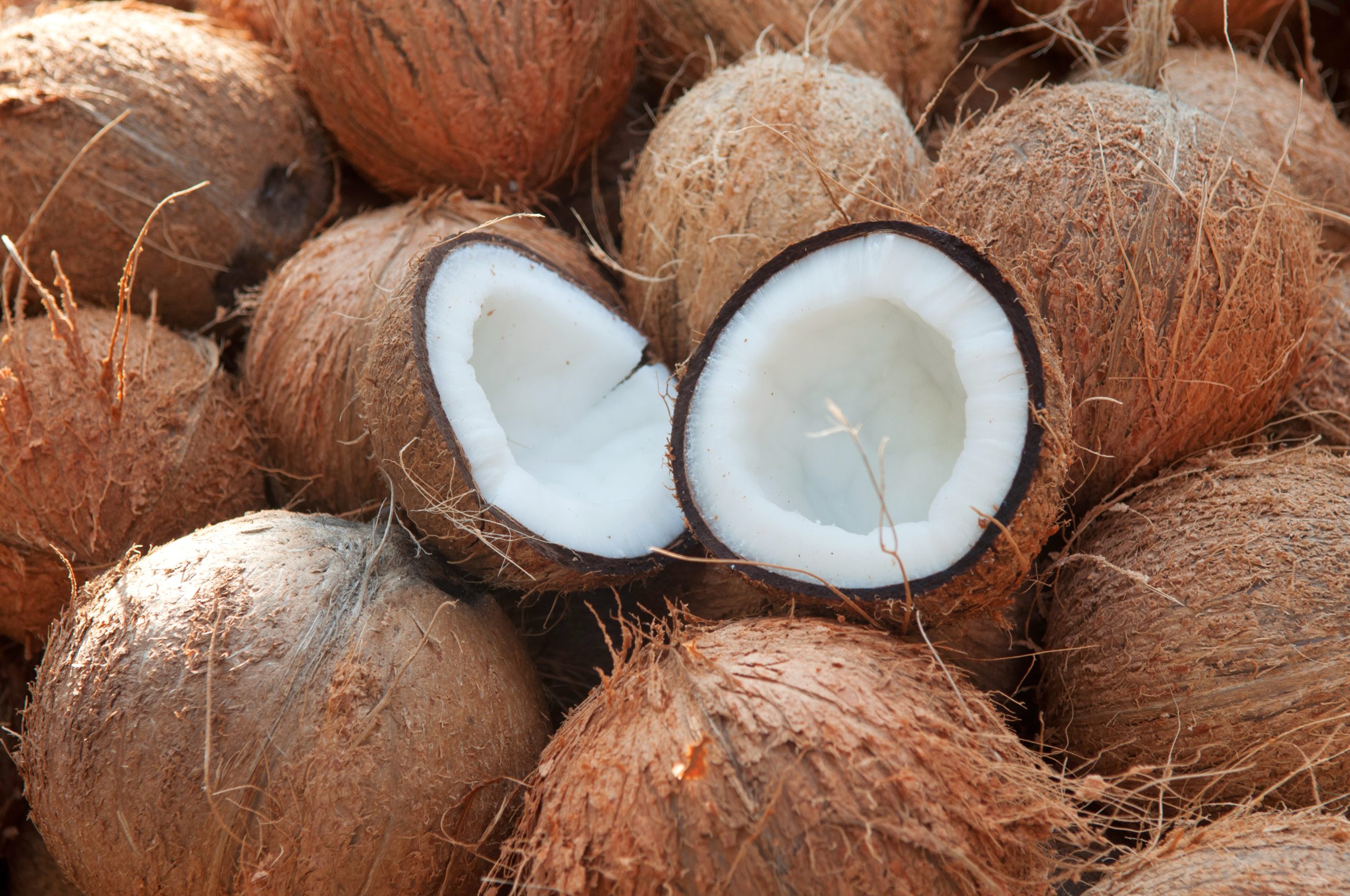Coconuts are a versatile and widely-used fruit with numerous health benefits and culinary uses. From the water to the fruit's meat, coconuts are packed with nutrients and can be used in sweet and savory dishes.
Table of Contents
What is a Coconut?
Coconut is the fruit of the coconut palm (Cocos nucifera) and is a member of the palm family Arecaceae.
Coconuts are typically found in tropical regions such as Southeast Asia, the Caribbean, and South America. They grow on palm coconut trees, often considered the “Tree of life,” and are harvested when fully mature, indicated by the fruit’s brown, hairy exterior.
Inside the hard shell, the coconut’s flesh is called copra. Copra is usually divided into two parts: the solid white meat and the coconut water, a clear liquid found inside the fruit.
Regarding visual attributes, coconuts have a rough, fibrous outer shell, typically brown or tan. The thick and hard shell makes it difficult to crack open without special tools. The interior flesh can be either thick and meaty or thin and jelly-like, depending on the age and maturity of the fruit.
The coconut fruit is considered a drupe and has three layers (the first two are part of the husk):
- The Exocarp – A yellow-green or yellow and brown outer skin
- The Mesocarp – The fleshy middle layer made from a fiber called coir
- The Endocarp – The coconut’s shell that is filled with endosperm (the coconut water)
Coconuts are known for their distinct tropical taste. The flesh is sweet and nutty, with a subtle, creamy texture often used in various dishes, drinks, and smoothies. The flakes can also be used as a garnish for dishes like klepon and puto bumbong.
Indonesia, the Philippines, and India produce 75% of the world’s coconut supply.
The History of Coconuts
Researchers have found that the origins of coconuts are tied to two different populations. One population has roots (literally) in the Pacific basin and the other in the Indian Ocean basin, suggesting that the coconut was brought originally under cultivation in two completely separate locations.
Coconut genetics also provide a record of prehistoric trade routes and the colonization of the Americas. The coconut’s history is closely linked to human travel, as people have been carrying and trading coconuts for centuries.
Morphology was previously used to identify domesticated plants, but the lack of universal domestication traits in coconuts made it difficult to trace their origins. However, DNA analysis has revealed the coconut’s cultivation origins, showing that there are two distinctively different forms of the coconut fruit:
- The niu vai form is rounded and contains abundant sweet coconut “water” when unripe.
- The niu kafa form is triangular and oblong with a sizeable fibrous husk.
What Does a Coconut Taste Like?
Coconut has a sweet, nutty flavor with a slightly creamy and crunchy texture.
When eaten raw, the white flesh inside the coconut, also known as coconut meat, has a mild and refreshing flavor. It can be eaten as is or grated and used in various dishes and desserts.
Coconut meat can take on a richer and more complex flavor when cooked. Coconut milk and cream are commonly used in curries, stews, soups, and desserts, adding a creamy and slightly sweet taste. Coconut oil extracted from the meat has a distinct and nutty flavor and is often used in cooking and baking.

How to Tell When Coconuts are Ripe
There are several ways to tell when coconuts are ripe, including the color, weight, sound of the water inside, and if the coconut has sprouted.
| Color | A ripe coconut will have a dark brown, hairy outer shell. The color may vary depending on the type of coconut, but it should be dark and uniform. |
| Sound | When you shake a mature coconut, you should hear water sloshing inside the coconut shell. The coconut may not be ripe if there is no sound or only a faint one. |
| Weight | A ripe coconut will feel heavy for its size because it contains water and meat. A young coconut will feel light. |
| Sprouting | If a coconut is left on the ground for too long, it may start to sprout from one of the three eyes. This indicates it is overripe and may have little meat or water left. |
Cooking with Coconuts
You must remove the hard outer shell to prepare a coconut for cooking. Here are the steps to do so:
- Locate the “eyes” of the coconut. These are small, round indentations on one end of the coconut.
- Use a pointed tool to poke holes in two of the eyes.
- Drain the coconut water into a container.
- Place the coconut on a hard surface and tap it with a hammer or other heavy object until it cracks open.
- Use a knife to separate the coconut meat from the shell. You can do this by running the knife between the flesh and the outside and gradually working around the perimeter.
Coconut is a versatile ingredient that can be used in both sweet and savory dishes. Here are some common cooking methods:
Grated coconut: Coconut can be grated and used in curries, stews, and soups.
Coconut milk: Coconut milk is made by blending grated coconut with water and then straining out the solids. It is used in many Southeast Asian cuisines, such as Thai and Indonesian, as a base for curries and soups.
Coconut oil: Coconut oil is a popular cooking oil in many tropical regions. It has a high smoke point and a distinct coconut flavor.
Coconut flour: Coconut flour is made from dried coconut meat ground into a fine powder. It is gluten-free and often used in baking as a substitute for wheat flour.
Coconut is a staple ingredient in many cuisines worldwide, including Thai, Indian, Caribbean, and Pacific Islander cuisine.
Coconut Recipes
Here are some of our favorite dishes where coconut is the star of the show!
Thai Green Curry: This popular Thai dish uses coconut milk as a base and is flavored with beans, garlic, and lime leaves. And, of course, it includes chicken and some savory fish sauce for the perfect flavor mix.
Indian Coconut Chutney: This is a spicy and tangy condiment made from coconut, roasted chana dal, ginger, and green chilies and elevated with curry leaves. It is often served with dosa or idli, which are Indian savory pancakes.
Jamaican Coconut Rice and Peas: This traditional Jamaican side is made with coconut milk, kidney beans, and rice and is complemented by many delightful spices. It is often served with jerk chicken or meats.
Pacific Islander Coconut Cream Fish: This is a simple and flavorful Pacific Islander dish that features fish cooked in coconut cream with onion, chili, lemon juice, and tomatoes. It is often served with rice and vegetables.

How to Store Coconuts
If you’re looking to preserve your whole coconut, there are several options, depending on how long you want to keep it fresh.
- A whole coconut can last for around one week at room temperature before it spoils. However, keep in mind that exposure to heat and humidity can speed up the process of spoilage, so it’s best to store your coconut in a cool, dry place away from direct sunlight.
- A whole coconut can last up to 2-3 weeks when stored properly in the fridge. To do so, wrap the coconut in plastic wrap or store it in an airtight container to prevent moisture and odors from affecting the fruit.
- Additionally, a whole coconut can be kept in the freezer for 6-8 months without losing its freshness.
Health Benefits of Coconuts
Coconut has numerous potential health benefits that can be enjoyed in a balanced diet. It is rich in fiber, aiding digestion and keeping you feeling full. It also contains iron, magnesium, potassium, vitamin C, zinc, copper, manganese, and selenium.
Coconut meat contains a significant amount of medium-chain fatty acids (MCFAs), a type of saturated fat that the body finds easier to digest than animal fats. These MCFAs improve endurance in trained athletes and can promote oral health by helping prevent dental infections and cavities.
Coconut may also improve heart-protective HDL cholesterol levels. However, it may also increase harmful LDL cholesterol levels if consumed without moderation.
Coconut water is a good source of potassium, which helps balance sodium levels in the body and regulate blood pressure. Additionally, coconut oil can improve skin health by locking in moisture and improving the skin’s barrier function, making it a popular choice for those with dry skin or eczema.

Where to Purchase Coconuts
The best time to find fresh coconuts may depend on where you live, but they are generally available throughout the year in most grocery stores. In some regions, the peak coconut season may occur during the summer or fall, while in others, it may be in the winter or spring.
If you cannot find fresh coconuts, you’re still likely to find packaged coconut products such as coconut water, coconut milk, coconut oil, and shredded coconut. These products are usually readily available year-round and are often found in the baking or health food aisles.

